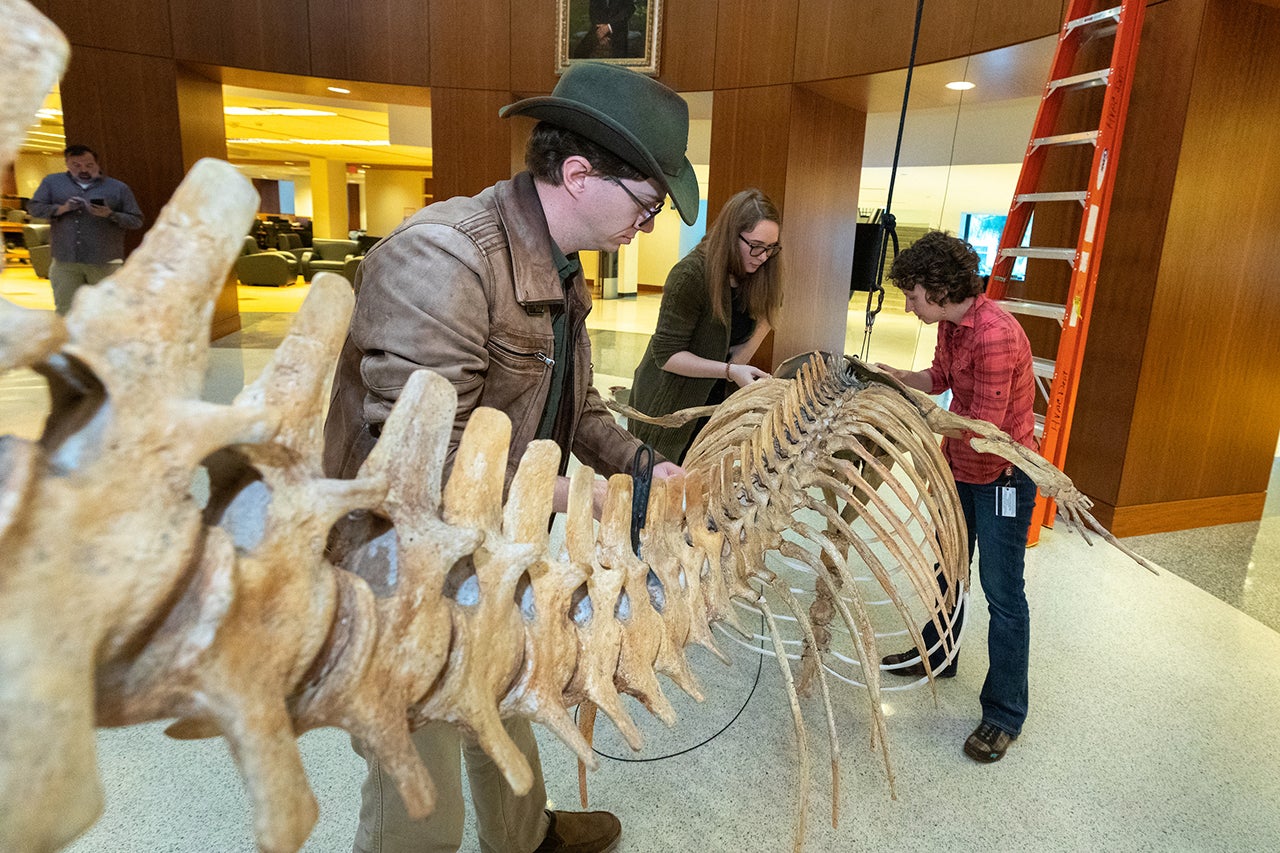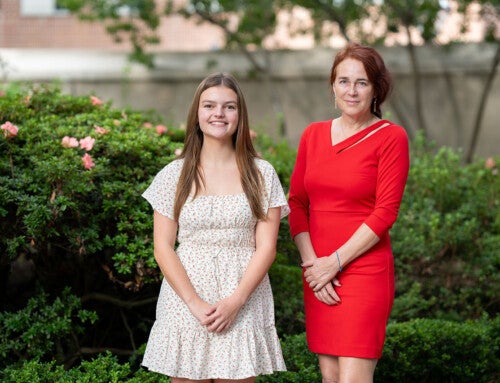The next time you pass through the rotunda in the College of Charleston’s Addlestone Library, look up.
Beginning Dec. 18, 2019, studious Cougars have a new companion: Dorudon atrox.
Latin for “spear-tooth,” Dorudon lived up to its name. With its razor-sharp triangular teeth, an observer might confuse it for a marine reptile.
They’d be forgiven; for many decades, scientists mistook similar fossils for those belonging to giant reptiles.

Sarah Boessenecker oversees the installation of the whale skeleton in the Addlestone Library. (Photo by Heather Moran)
“Dorudon was a true sea monster that patrolled the prehistoric coast of South Carolina,” says Scott Persons, assistant professor of geology and curator of the College’s Mace Brown Museum of Natural History.
But the 20-foot skeletal cast calling the Rotunda home for the next year represents a profound moment in the evolutionary history not of dinosaurs, but of mammals: Dorudon were among the first fully-marine whales.
The first fossils of Dorodon were discovered in South Carolina, but the ancient whale swam throughout the prehistoric North Atlantic. This specific Dorudon cast is based on two different skeletons excavated nearly three decades ago in Egypt, in an area nicknamed the “Valley of the Whales.”
For many years, it hung in San Francisco’s Discovery Channel Store before being rescued by paleoichthyologist Douglas J. Long.
He assigned it a crucial task.
After leaving Discovery, “this whale spent the next 15 years guarding over a hoard of precious rum in Doug’s Tiki Bar, where it was named ‘Manaia’ – a mythological creature in the Maori culture that is a guardian against evil and serves as a messenger between the world of the living and the dead,” says Robert Boessenecker, marine mammal paleontologist in the College’s Department of Geology and Environmental Geosciences and a friend of Long’s. “It’s quite an apt assignment for a spectacular 36-million-year-old skeleton that will be teaching students about the past earth long into the future!”
But what do we know about this mysterious animal from millennia ago? What does it reveal about modern whales? What can it teach us about the trials and triumphs of mammal-life itself?
***
Trace the evolution of whales far enough back and you’ll find yourself not in the open ocean, but on land. As mammals, all whales – and dolphins and porpoises – descend from land-dwellers.
Scientists have determined that whales’ ancestors were furry, wolf-sized fish-eaters living in rivers and lakes 50 million years ago. As they slowly adapted to aquatic life, these creatures discarded some of their mammalian characteristics and retained others.
Dorudon descended from these transitional animals and were still in evolutionary flux.
“Unlike modern whales, Dorudon still has a tiny set of vestigial back legs, which you can spot dangling at the skeleton’s rear,” says Persons. “And there are a number of cool features to look for on the skeleton. In the jaws, you can see several different kinds of teeth, for puncturing and cutting prey in different ways.”
The Dorudon diary begins in the Eocene Epoch 56-33.9 million years ago. For some chronological perspective, large dinosaurs had disappeared and the ancestors of many mammals with us today – from the first elephant-esque animals to early bats – made their planetary debut.
At this time, the Earth’s plates had begun to assume their contemporary locations. Environmental conditions, however, were radically different from today – what became South Carolina spent much of this epoch underwater.
The Eocene witnessed the appearance of many new organisms. But even during an epoch of startling change, Dorudon – and the family to which they belong, Basilosauridae – were something special: the first completely marine whales.
Life was not easy for Dorudon; the ocean’s a tough neighborhood.
Compared to today’s whales – which count amongst themselves the largest toothed predators on the planet – Dorudon were small, about the size of the modern Beluga.
They could swim fast, but not fast enough. Fossilized Dorudon remains have been found in the stomachs of their larger cousins, Basilosaurus. Paleontologists have also unearthed juvenile Dorudon skulls that were bitten in half, presumably by their larger whale relatives.
And while they possessed the biological equipment for hearing underwater, they lacked the particular organ that allows modern whales to echolocate.
To scientists, Dorudon is like a rough draft.
“Look closely at the top of the skull and you will notice that the nostrils are not at the snout tip, but nor are they all the way on the forehead,” Persons says. “Dorudon did not have a blowhole like a modern whale, but it was evolving in that direction.”
***
How did this fossil cast-turned-bouncer find its way to Charleston?
Fortunately for the College, ‘Manaia’ was looking for a new job.

Scott Persons and Robert Boessenecker assess the Dorudon‘s position in the rotunda. (Photo by Heather Moran)
“After 15 years protecting the Tiki Bar, Dr. Long was hired to a new job in southern California and generously offered to give us Manaia if we were able to cover logistical costs,” Boessenecker says. “Thanks to the generosity of our very own Mace Brown, Manaia arrived here this semester at a fraction of the cost of a brand-new cast.”
And Manaia, undoubtedly, will feel at home in Charleston.
“Although the best fossils of Dorudon were discovered in Egypt, the first fossils of Dorudon ever discovered were found right here in the South Carolina Lowcountry, in the vicinity of Lake Marion near I-95 at Mazyck Plantation in the 1840s – possibly by slaves – and named by Robert Gibbes of Charleston’s prominent Gibbes family,” Boessenecker says. “Having the specimen here is an extraordinary teaching tool. Dorudon is the common ancestor of all modern baleen whales and dolphins. This radiation was driven by the eventual evolution of echolocation and filter feeding. Charleston is the best place in the world to study this radiation.”
Manaia did not arrive at the College ready for display. The old skeleton had several missing parts and broken ribs. To fill in these gaps, College of Charleston students Addison Miller and Shelley Copland assisted museum collections manager Sarah Boessenecker and Robert Boessenecker in 3D printing and painting replacement parts.
“Almost a million patrons visit Addlestone Library annually and we can’t be more excited that Manaia will greet them over the coming year,” says John White ’99, dean of the College Libraries. “We believe that libraries should be places for inquiry and discovery. I am certain that this new exhibit will serve as inspiration for our students, faculty and patrons.”
Manaia is free to view for the College community and public during Addlestone Library’s regular hours now through December 2020.
This installation is made possible by the Mace Brown Museum of Natural History, the Department of Geology and Environmental Geosciences, the School of Sciences and Mathematics, and the College of Charleston Friends of the Library.
Featured image: Scott Persons assists in assembling the Dorudon fossil in Addlestone Library. (Photo by Heather Moran)





